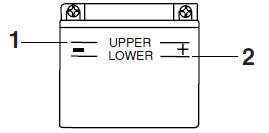Yamaha YZF-R125 Owners Manual: Battery
A poorly maintained battery will corrode and discharge quickly. The electrolyte level, battery lead connections and breather hose routing should be checked before each ride and at the intervals specified in the periodic maintenance and lubrication chart.
 WARNING
WARNING
- Electrolyte is poisonous and dangerous since it contains sulfuric acid, which causes severe burns. Avoid any contact with skin, eyes or clothing and always shield your eyes when working near batteries. In case of contact, administer the following FIRST AID.
- EXTERNAL: Flush with plenty of water.
- INTERNAL: Drink large quantities of water or milk and immediately call a physician.
- EYES: Flush with water for 15 minutes and seek prompt medical attention.
- Batteries produce explosive hydrogen gas. Therefore, keep sparks, flames, cigarettes, etc., away from the battery and provide sufficient ventilation when charging it in an enclosed space.
- Take care not to spill electrolyte on the drive chain, as this may weaken it, shorten chain life and possibly result in an accident.
- KEEP THIS AND ALL BATTERIES OUT OF THE REACH OF CHILDREN.
To check the electrolyte level
- Place the vehicle on a level surface and hold it in an upright position.
TIP
Make sure that the vehicle is positioned
straight up when checking the electrolyte
level.
- Check the electrolyte level in the battery.
TIP
The electrolyte should be between the
minimum and maximum level marks.

-
Maximum level mark
-
Minimum level mark
- 3. If the electrolyte is at or below the minimum level mark, add distilled water to raise it to the maximum level mark. NOTICE: Use only distilled water, as tap water contains minerals that are harmful to the battery.
- Check and, if necessary, tighten the battery lead connections and correct the breather hose routing.
To store the battery
- If the motorcycle will not be used for more than one month, remove the battery, fully charge it, and then place it in a cool, dry place. NOTICE: When removing the battery, be sure the key is turned to "OFF", then disconnect the negative lead before disconnecting the positive lead.
- If the battery will be stored for more than two months, check the specific gravity of the electrolyte at least once a month and fully charge the battery whenever necessary.
- Fully charge the battery before installation.
- After installation, make sure that the battery leads are properly connected to the battery terminals and that the breather hose is properly routed, in good condition, and not obstructed. NOTICE: If the breather hose is positioned in such a way that the frame is exposed to electrolyte or gas expelled from the battery, the frame could suffer structural and external damages.
 Checking the wheel bearings
Checking the wheel bearings
The front and rear wheel bearings must
be checked at the intervals specified in
the periodic maintenance and lubrication
chart. If there is play in the wheel
hub or if the wheel does not turn ...
 Replacing the fuses
Replacing the fuses
Replacing the fuses
Fuse box
Spare fuse
Headlight fuse
Signaling system fuse
Ignition fuse
Radiator fan fuse
Main fuse
The fuse box is located under the rider
seat.
If a fuse ...
Other materials:
Installing the front brake master cylinder
1. Install:
Brake master cylinder "1"
Brake master cylinder holder "2"
NOTE:
Install the brake master cylinder holder with the
arrow mark "a" pointing forward.
Align the end of the brake master cylinder holder
with the punch mark "b" on the handlebar.
First, tighten the front bo ...
Troubleshooting
Any of the following fail to light: turn signal lights, brake light or
indicator lights.
The horn fails to sound.
The fuel gauge fails to operate.
The speedometer fails to operate.
NOTE:
Before troubleshooting, remove the following part(s):
1. Seats
2. Fuel tank
3. Left upper ...
Genuine Yamaha Accessories
Choosing accessories for your vehicle
is an important decision. Genuine
Yamaha accessories, which are available
only from a Yamaha dealer, have
been designed, tested, and approved
by Yamaha for use on your vehicle.
Many companies with no connection to
Yamaha manufacture parts and access ...
